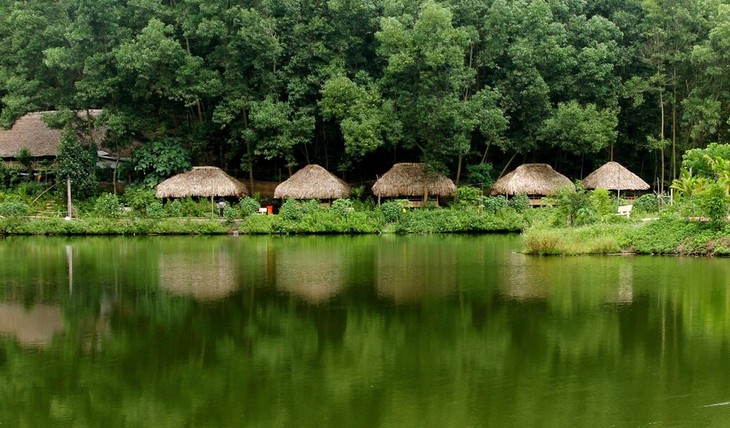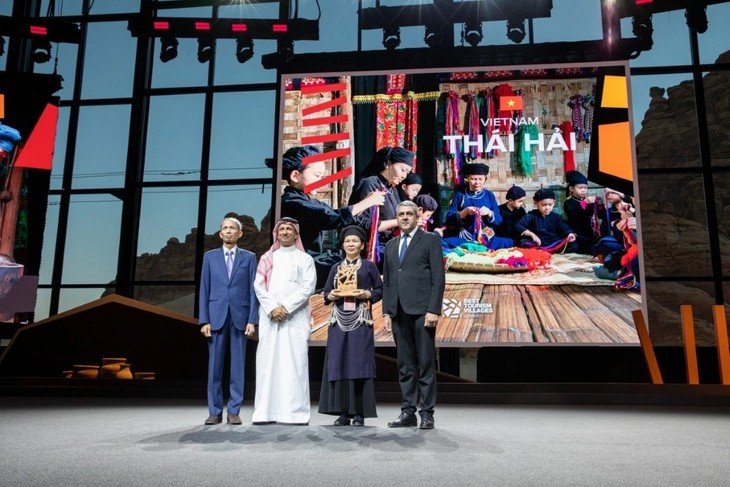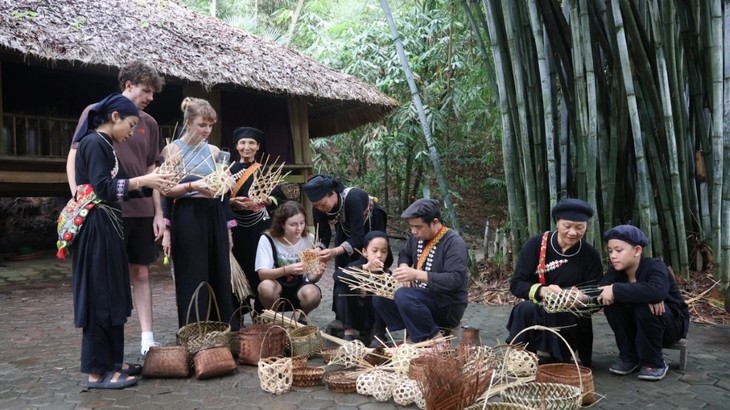Thai Hai Village, also called Thai Hai Family, nestles quietly amidst the lush mountains and forests of Thai Nguyen province. Recognized as Vietnam’s first “Best Tourism Village” by the UN Tourism Organization in 2022, Thai Hai is an impressive attraction and a symbol of unity, cultural preservation, and sustainable development.

Thai Hai Conservation Village of Ecological Ethnic Stilt Houses in Thai Nguyen province (Photo: Thai Hai village)
The Thai Hai Conservation Village of Ecological Ethnic Stilt Houses is in Thinh Duc commune, Thai Nguyen province. Covering an area of around 25 hectares surrounded by mountains, the village is inhabited by 200 people of the Tay, Nung, Cao Lan, San Chi, and Kinh groups. The Tay people make up the majority, with many families of three or four generations living together.
Two decades ago, Nguyen Thi Thanh Hai, a Tay ethnic woman, made a bold decision that no one had taken before. She mortgaged all of her property to buy 30 old stilt houses and relocated them to My Hao hamlet. Over approximately seven years, she hired locals to carry all the parts of the stilt houses, crossing 60 kilometers of zigzagged forest paths, to rebuild them in My Hao.
Le Thi Nga, Deputy Head of Thai Hai village, said: “The village chief, Nguyen Thi Thanh Hai, came and bought this land to establish a village. People planted trees to regenerate the forest and rebuilt the stilt houses to preserve the Tay culture.”
By the end of 2003, 28 stilt houses were built with palm-thatched roofs and sturdy wooden pillars according to the yin-yang and five-element philosophy. The early years were difficult, but all villagers stood united to farm and raise livestock. Gradually, Thai Hai transformed into a peaceful, prosperous hamlet. Even more remarkably, this once poor and remote area became a model tourism village recognized by the World Tourism Organization.
In Thai Hai, development is closely tied to preserving their ethnic culture. Tangible cultural values are revived through traditional stilt houses, furniture, and farm tools. There is a rice mill, a water-powered rice mill, woven baskets, and wells on the yard, reflecting a traditional landscape.
Intangible culture is passed down through family life. All children attend school, learn their native language and folk culture, such as singing Then songs, playing the Tinh lute, and playing traditional games like Nem con, throwing a cloth ball. Local cuisine and worship rituals are documented to be handed down to future generations.

UN Tourism Organization hands over the certificate "Best Tourism Village" to Thai Hai village. (Photo: Thai Hai village)
Within the village, a conservation area is organized to showcase traditional crafts and products. There is a tea house introducing tea growing and processing methods; a medicine house preserving and prescribing herbal remedies to locals and visitors; a wine house brewing traditional herbal liquor; a cake house making Banh chung (square sticky rice cake), Banh gai (black glutinous rice cake), and Che lam (glutinous rice candy); and a weaving house producing bamboo and rattan household utensils and souvenir.
Villager Le Thi Hao said: “I’m a descendant of the Kinh and didn’t know anything about weaving. Since I moved here, I learned weaving from the Tay villagers. The villager elders taught me the craft. Then I taught my children and grandchildren weaving, so they can help preserve the village’s culture.”
In 2014, Thai Hai was officially recognized as a tourist destination. While most other tourist sites follow individualized business models, Thai Hai villagers uphold a communal lifestyle of working and sharing benefits. No one keeps personal money. All income from farming, production, and tourism goes to the village’s shared fund. All expenses, from daily meals to children's education, are covered by the community.
Deputy Village Chief Le Thi Nga said Thai Hai set out from the beginning not to commercialize tourism, but to preserve their culture. Visitors come here to experience a different way of life, where they don’t stay in luxurious hotel rooms, but in stilt houses, enjoy simple meals served with hospitality and be treated as a family member.
The village also offers more experiential spaces, such as a golden bridge, a silver bridge, the Tay New Year celebration, herbal foot soaking services, and reenactment of traditional festivals like the Long Tong (Going to the Field Festival), Gratitude Ceremony, and Mother Worship Ceremony.

Tourists can enjoy hands-on activities in crafting traditional products. (Photo: Thai Hai village)
Thai Hai now offers over 100 traditional dishes, such as braised pork, grilled buffalo meat, braised carp with sour bamboo, wild banana flower salad, and five-colored sticky rice, according to the Deputy Village Chief.
“Our ancestors worked hard to build the village, so we must continue nurturing it with a deep love for our culture and heritages. Besides that, we must enhance our cultural knowledge to share it with visitors. The younger generation always wishes to be cultural ambassadors to introduce the beauty of our heritage to a wider public.”
The peace, beauty, and values stemming from the harmony between people, nature, and culture have made Thai Hai appealing to visitors to Thai Nguyen. Especially since it received the “Best Tourism Village” award from the World Tourism Organization in 2022, Thai Hai has welcomed an increasing number of domestic and international tourists. Each year, the village welcomes thousands of visitors from over 40 countries around the world.